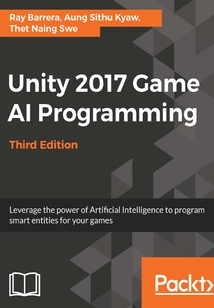舉報 

會員
Unity 2017 Game AI Programming(Third Edition)
ThisbookisintendedforUnitydeveloperswithabasicunderstandingofC#andtheUnityeditor.Whetheryou'relookingtobuildyourfirstgameorarelookingtoexpandyourknowledgeasagameprogrammer,youwillfindplentyofexcitinginformationandexamplesofgameAIintermsofconceptsandimplementation.
目錄(170章)
倒序
- 封面
- 版權信息
- Packt Upsell
- Why subscribe?
- PacktPub.com
- Contributors
- About the authors
- About the reviewer
- Packt is searching for authors like you
- Preface
- Who this book is for
- What this book covers
- To get the most out of this book
- Download the example code files
- Download the color images
- Code in Action
- Conventions used
- Get in touch
- Reviews
- The Basics of AI in Games
- Creating the illusion of life
- Neural Networks
- Leveling up your game with AI
- Using AI in Unity
- Defining the agent
- Finite State Machines
- Seeing the world through our agent's eyes
- Path following and steering
- Dijkstra's algorithm
- Using A* Pathfinding
- IDA* Pathfinding
- Using Navigation Mesh
- Flocking and crowd dynamics
- Behavior trees
- Thinking with fuzzy logic
- Summary
- Finite State Machines and You
- Technical Requirements
- Finding uses for FSMs
- Creating state machine behaviors
- Creating the AnimationController asset
- Layers and parameters
- The animation controller inspector
- Bringing behaviors into the picture
- Creating our very first state
- Transitioning between states
- Setting up our player tank
- Creating the enemy tank
- Choosing transitions
- Making the cogs turn
- Setting conditions
- Driving parameters via code
- Making our enemy tank move
- Testing
- Summary
- Implementing Sensors
- Technical Requirements
- Basic sensory systems
- Cone of sight
- Hearing feeling and smelling using spheres
- Expanding AI through omniscience
- Getting creative with sensing
- Setting up the scene
- Setting up the player tank and aspect
- Implementing the player tank
- Implementing the Aspect class
- Creating an AI character
- Using the Sense class
- Giving a little perspective
- Touching is believing
- Testing the results
- Summary
- Finding Your Way
- Technical Requirements
- Following a path
- The path script
- Using the path follower
- Avoiding obstacles
- Adding a custom layer
- Obstacle avoidance
- A* Pathfinding
- Revisiting the A* algorithm
- Implementation
- The Node class
- Establishing the priority queue
- Setting up our grid manager
- Diving into our A* implementation
- Implementing a TestCode class
- Testing it in the sample scene
- Testing all the components
- A* vs IDA*
- Navigation mesh
- Inspecting our map
- Navigation Static
- Baking the navigation mesh
- Using the NavMesh agent
- Setting a destination
- Making sense of Off Mesh Links
- Summary
- Flocks and Crowds
- Technical Requirements
- Learning the origins of flocks
- Understanding the concepts behind flocks and crowds
- Using the Reynolds algorithm
- Implementing the FlockController
- The flock target
- The scene layout
- Using crowds
- Implementing a simple crowd simulation
- Using the CrowdAgent component
- Adding some fun obstacles
- Summary
- Behavior Trees
- Technical Requirements
- Learning the basics of behavior trees
- Understanding different node types
- Defining composite nodes
- Understanding decorator nodes
- Describing the leaf node
- Evaluating the existing solutions
- Implementing a basic behavior tree framework
- Implementing a base Node class
- Extending nodes to selectors
- Moving on to sequences
- Implementing a decorator as an inverter
- Creating a generic action node
- Testing our framework
- Planning ahead
- Examining our scene setup
- Exploring the MathTree code
- Executing the test
- HomeRock card game example
- The scene setup
- The enemy state machine
- Testing the game
- Summary
- Using Fuzzy Logic to Make Your AI Seem Alive
- Technical Requirements
- Defining fuzzy logic
- Picking fuzzy systems over binary systems
- Using fuzzy logic
- Implementing a simple fuzzy logic system
- Expanding the sets
- Defuzzifying the data
- Using the resulting crisp data
- Using a simpler approach
- The morality meter example
- The question and answer classes
- Managing the conversation
- Loading up the questions
- Handling user input
- Calculating the results
- Scene setup
- Testing the example
- Finding other uses for fuzzy logic
- Merging with other concepts
- Creating a truly unique experience
- Summary
- How It All Comes Together
- Technical Requirements
- Setting up the rules
- Creating the towers
- Making the towers shoot
- Setting up the tank
- Bonus tank abilities
- Setting up the environment
- Testing the example
- Summary
- Other Books You May Enjoy
- Leave a review - let other readers know what you think 更新時間:2021-07-02 19:14:39
推薦閱讀
- Learning Spring 5.0
- Java高并發核心編程(卷2):多線程、鎖、JMM、JUC、高并發設計模式
- Visual Basic程序開發(學習筆記)
- Django Design Patterns and Best Practices
- 名師講壇:Java微服務架構實戰(SpringBoot+SpringCloud+Docker+RabbitMQ)
- Flux Architecture
- 網站構建技術
- INSTANT Passbook App Development for iOS How-to
- C#應用程序設計教程
- PHP 7從零基礎到項目實戰
- SQL Server 入門很輕松(微課超值版)
- Arduino機器人系統設計及開發
- H5+移動營銷設計寶典
- Learning Alfresco Web Scripts
- Illustrator CS6中文版應用教程(第二版)
- Learning Scrapy
- HTML 5與CSS 3權威指南(第3版·下冊)
- 電子系統設計基礎
- C語言程序開發范例寶典
- 軟件測試技術基礎教程:理論、方法、面試
- Java修煉指南:核心框架精講
- Learning OpenStack Networking
- MATLAB編程與最優化設計應用
- Jupyter for Data Science
- Big Data Analytics with R
- Developing AR Games for iOS and Android
- 劍指JavaWeb:技術詳解與應用實踐
- Python深度強化學習:基于Chainer和OpenAI Gym
- TypeScript+Vue.js前端開發從入門到精通
- Hands-On Data Science and Python Machine Learning

